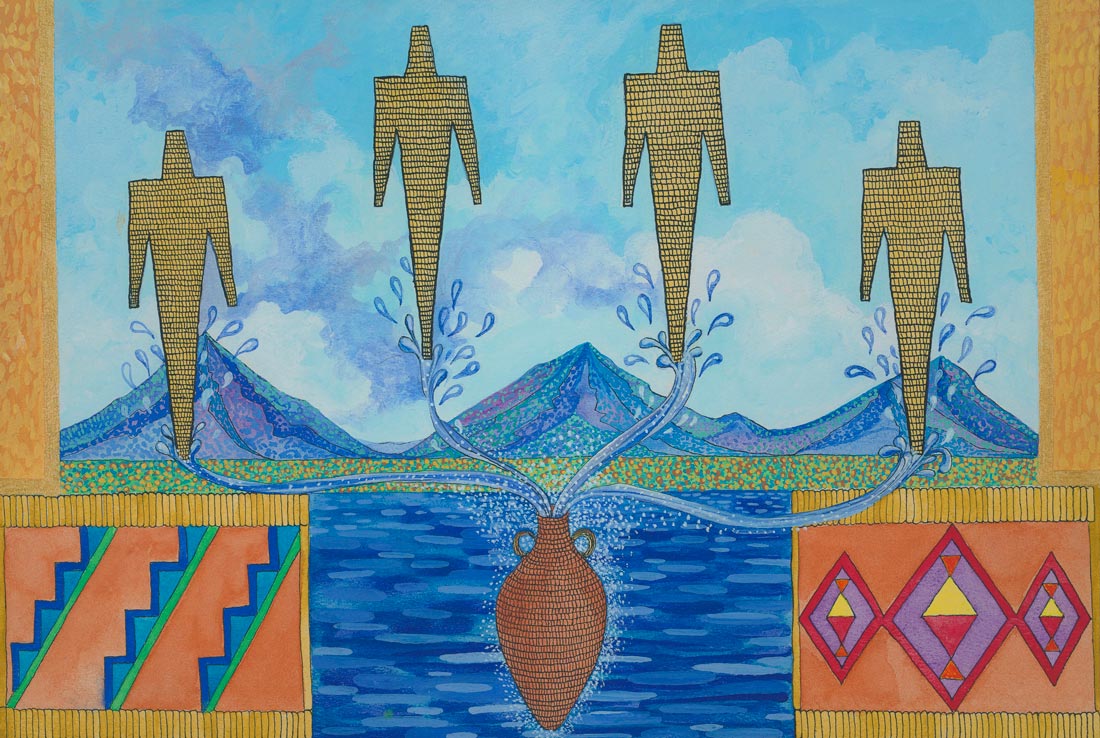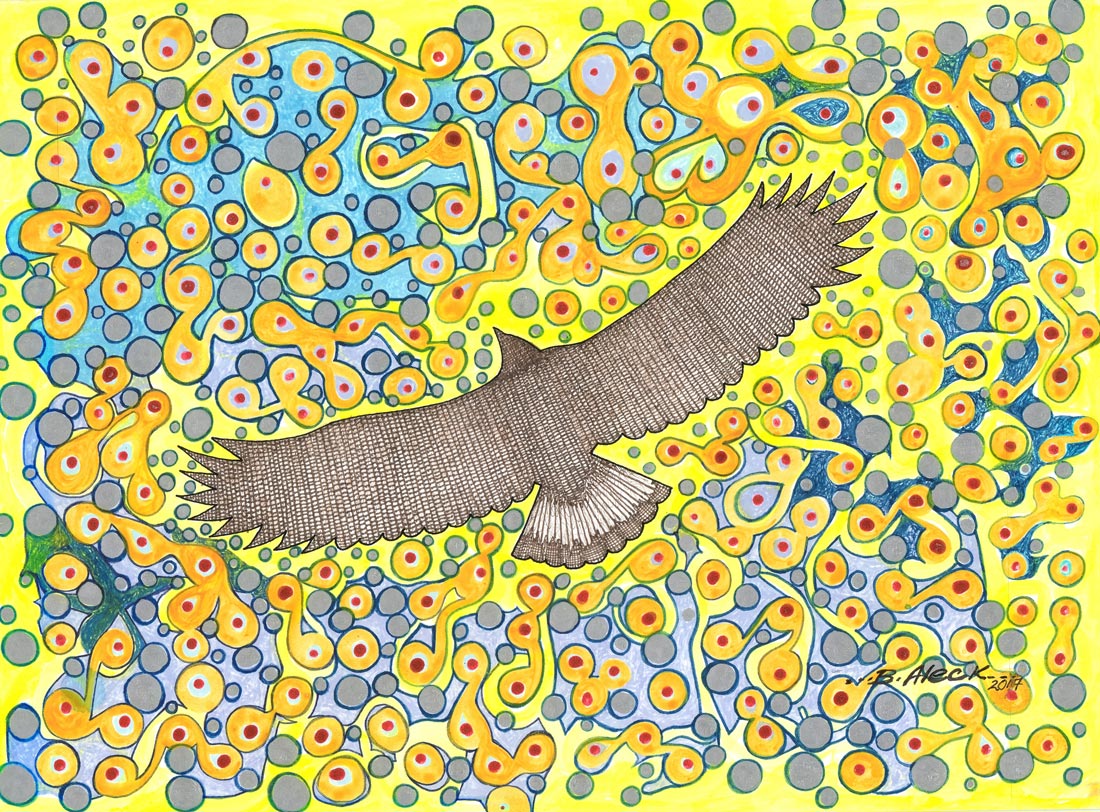Ben Aleck sharing his Pyramid Lake Paiute Tribe heritage at Nevada Museum of Art
By Medicine Man Gallery on

Ben Aleck, Kwe'naa'a (eagle), circa 2010, acrylic on canvas, 6 x 10 feet. Collection of the Reno Sparks
Geometry and eagles seemingly have nothing in common. To members of the Pyramid Lake Paiute Tribe (Kooyooe Tukadu/cui-ui fish eaters) like artist Ben Aleck, however, they have everything in common which is why both themes repeat throughout his work.
“The geometrics come from the beadwork and basket designs of the Pyramid Lake Paiute tribe and Great Basin tribes,” Aleck explains.
Pyramid Lake is located forty miles northwest of Reno within the boundaries of the Pyramid Lake Paiute Reservation along Nevada’s western border with California.
“We have a lot of eagles out at Pyramid Lake, and when you go out and you see them, they are just soaring by the lake and it’s a really beautiful image to see, so I include it in my paintings,” Aleck said.
His geometry and eagles can be seen now through January 7, 2024, during the exhibition “The Art of Ben Aleck” at the Nevada Museum of Art in Reno. The exhibition features over thirty of Aleck’s paintings, drawings and mixed-media artworks, many pairing geometry and eagles, and traces his long career through works emphasizing deep connections between Indigenous communities and the Great Basin.
Broadly speaking, the Great Basin covers almost all of Nevada, the western half of Utah and slivers of Idaho, Oregon and California. Among other things, the area is connected by its hydrology. All precipitation in the region evaporates, sinks underground or flows into lakes as opposed to finding outlet to either the Gulf of Mexico or Pacific Ocean as is the case with all other rainwater across the U.S. West.
Aleck’s art often relays stories of the plants, animals, and geography of Pyramid Lake, giving visual form to Indigenous stories about the stars, coyotes, the formation of Great Basin lands, and the origins of its people.
“I like to include nature in my work. It is an expression of the world around us,” he said. “The animals have a lot to teach us. The eagle is important because they lend to us their feathers for ceremony, medicine and traditional regalia.”
Aleck simultaneously tackles issues involving the environment and water use, a common theme among Native artists throughout this vast section of the country.
“Indigenous art of this region reflects the issues of this place,” Nevada Museum of Art Chief Curator and exhibition curator Ann Wolfe said. “While there is always a sensitivity and respect for the beauty of the natural environment, there is also an honest effort made by artists to raise issues about what threatens that beauty. Those things include water use and abuse, militarization of land and air space, ongoing nuclear testing, and natural resource extraction by corporations on a massive scale. Ben does not directly touch on all of these issues, but the Indigenous art produced in the Great Basin on a whole often does.”

Ben Aleck, Great Basin Tribes, 2019, Acrylic on paper, 16 ¾ x 23 inches. Collection of Melissa Melero
Child Prodigy
Aleck was born in Reno in 1949 and raised on the Reno Sparks Indian Colony. As an aspiring artist with unusual talent, he enrolled in art classes at the University of Nevada, Reno as a 12-year-old.
He shares an amusing anecdote from this time, Aleck’s instructor at university asking him as a 9th-grader to secure permission from his mother to participate in a figure drawing class featuring nude models. Typical to boys around the world, Aleck feigned his mother’s approval and good fortune resulted in neither his professor nor mother ever being the wiser.
The deception paid off. He began selling his work as a teenager to help his large family make ends meet.
After graduating in 1968, Aleck attended the California College of Arts and Crafts (now California College of the Arts) in Oakland. This was at the peak of anti-war protests and the counterculture movement in the Bay Area. He became involved with the American Indian Movement and participated in the American Indian Occupation of Alcatraz.
The area was a hotspot for Native people, young Native people in particular, including many artists, as a preferred destination of the federal government’s Urban Indian Relocation Program, another scheme to disassociate Natives from their cultures and homelands under the guise of “progress.”
Aleck earned a Bachelor of Fine Arts in Painting from CCA in 1972 and had his first solo exhibition that same year at the Nevada Museum of Art, then called the Sierra Nevada Art Gallery. Thus began a long relationship between the artist and institution continuing to this day. In addition to exhibitions of his work, he has presented at conferences, co-curated exhibitions, and helped the museum organize major community events.
Great Basin Native Artists Archive and Directory
Highlighting the partnership is the Great Basin Native Artists Archive and Directory. Housed at the museum’s Center for Art + Environment, the Archive and Directory was formed in 2012 by Aleck and fellow artist Melissa Melero-Moose (Fallon Paiute-Shoshone Tribe: Toi Ticutta/cattail eaters).
“We’d just had a group show at the Nevada Museum of Art and we saw what great energy there was among the Native American artist community,” Aleck remembers of the Archive’s founding. “We wanted to capture that and nurture it, so we started GBNA.”
The Archive is a free, open, public resource dedicated to Native American artists working in the Sierra Nevada and Great Basin region. It consists of artist files, records, and materials such as resumes, artist statements, biographies, publications, images, exhibition records, sketchbooks, and other artist working materials. The collection is a valuable record illuminating the full story of the Great Basin, a region often overlooked due to its expanse and remote, rural places.
“GBNA has really helped create a community of Native artists in the Great Basin who were always underrecognized,” Aleck said. “Now, every Native artist, living or deceased, has a place to preserve their story and their work in the archive, which is housed at the Nevada Museum of Art.”
Geometry, eagles, and a great deal more.

Ben Aleck, Eagle in Flight, 2017, Mixed media. Collection of the artist




